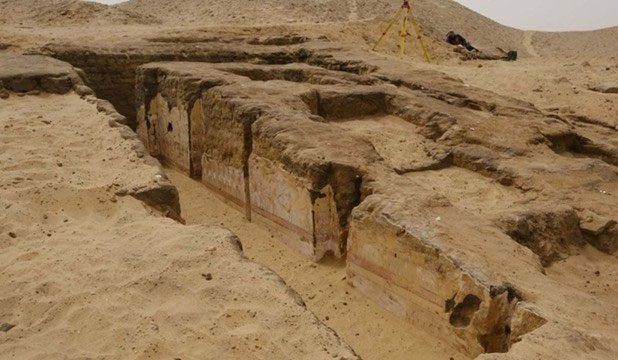A team of experts from the German Archaeological Institute in Cairo has recently announced the discovery of an ancient mastaba tomb dating back to the Old Kingdom period of Egypt.
The tomb features unique decorative paintings and was uncovered during the latest excavation at the Dahshour royal necropolis, located approximately 40 kilometers from Cairo.

Ancient tomb newly discovered in Egypt. (Source: Al-Ahram).
Hisham El-Leithy, an official from the Supreme Council of Antiquities of Egypt (SCA), stated that this discovery offers valuable insights into the political and social structure of ancient Egyptian society.
Stephan Seidlmayer, the head of the excavation team, revealed that studies indicate this is a mastaba tomb belonging to an ancient Egyptian, characterized by a truncated pyramid shape, constructed with mud bricks sourced from the Nile River, and possibly dating back to the end of the Fifth Dynasty or the beginning of the Sixth Dynasty.
In ancient Egyptian language, mastaba means “The Eternal House.”
According to this Egyptian archaeologist, inscriptions carved on a large limestone false door indicate that the mastaba tomb belonged to a man named Seneb-nebef, who held various administrative positions in the palace (khentiu-she), and his wife Idut, a priestess of the goddess Hathor.
Seidlmayer emphasized that what makes this discovery unique is the intricately painted decorations, which are rare in the Dahshour royal necropolis.
The exquisite artworks inside the tomb depict everyday scenes, including donkeys grinding grain, boats sailing on the Nile, bustling market scenes, and images of servants bringing offerings to the revered.
The Dahshour royal necropolis, situated south of the Saqqara archaeological site in Giza, is famous for its pyramids from the Old Kingdom period.
The delegation from the German Archaeological Institute in Cairo has been involved in excavations at the Dahshour necropolis since 1976, primarily focusing on the pyramids of Pharaoh Sneferu and the Middle Kingdom period.


















































